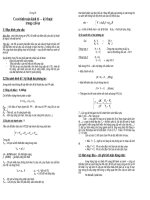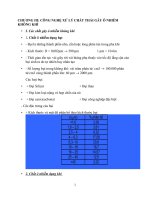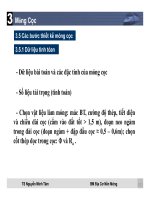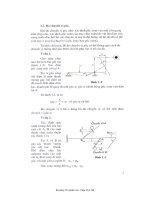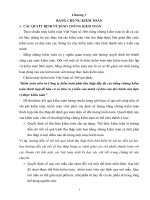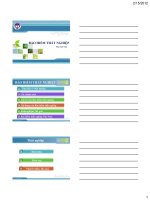Bài giảng môn MARKETING PRINCIPLE LECTURE NOTES: Chapter 3 analyze marketing environment
Bạn đang xem bản rút gọn của tài liệu. Xem và tải ngay bản đầy đủ của tài liệu tại đây (131.32 KB, 8 trang )
9/21/2017
Analyzing the Marketing
Environment
Topic Outline
• The Company’s Microenvironment
• The Company’s Macroenvironemnt
• Responding to the Marketing
Environment
Chapter Three
Analyzing the Marketing
Environment
Copyright © 2009 Pearson Education, Inc.
Publishing as Prentice Hall
Chapter 3- slide 1
Copyright © 2010 Pearson Education, Inc.
Publishing as Prentice Hall
Chapter 3- slide 2
The Marketing Environment
The Marketing Environment
The marketing environment includes
the actors and forces outside marketing
that affect marketing management’s
ability to build and maintain successful
relationships with target customers
Microenvironment consists of the actors
close to the company that affect its
ability to serve its customers -- the
company, suppliers, marketing
intermediaries, customer markets,
competitors, and publics
Copyright © 2010 Pearson Education, Inc.
Publishing as Prentice Hall
Chapter 3- slide 3
Copyright © 2010 Pearson Education, Inc.
Publishing as Prentice Hall
Chapter 3- slide 4
9/21/2017
•
•
•
•
•
•
The Company’s
Microenvironment
The Company’s
Microenvironment
The Company
Suppliers
Top management
Finance
R&D
Purchasing
Operations
Accounting
Copyright © 2010 Pearson Education, Inc.
Publishing as Prentice Hall
• Provide the resources to produce
goods and services
• Treated as partners to provide customer
value
Chapter 3- slide 5
Copyright © 2010 Pearson Education, Inc.
Publishing as Prentice Hall
Chapter 3- slide 6
The Company’s
Microenvironment
The Company’s
Microenvironment
Marketing Intermediaries
Types of Marketing Intermediaries
• Help the company to promote, sell
and distribute its products to final
buyers
Copyright © 2010 Pearson Education, Inc.
Publishing as Prentice Hall
Chapter 3- slide 7
Resellers
Physical
distribution
firms
Marketing
services
agencies
Financial
intermediaries
Copyright © 2010 Pearson Education, Inc.
Publishing as Prentice Hall
Chapter 3- slide 8
9/21/2017
The Company’s
Microenvironment
The Company’s
Microenvironment
Competitors
Publics
• Firms must gain strategic advantage
by positioning their offerings against
competitors’ offerings
Copyright © 2010 Pearson Education, Inc.
Publishing as Prentice Hall
Chapter 3- slide 9
• Any group that has an actual or potential
interest in or impact on an organization’s
ability to achieve its objectives
–
–
–
–
–
–
–
Financial publics
Media publics
Government publics
Citizen-action publics
Local publics
General public
Internal publics
Copyright © 2010 Pearson Education, Inc.
Publishing as Prentice Hall
Chapter 3- slide 10
The Company’s
Macroenvironment
The Company’s
Macroenvironment
Demographic Environment
Demographic Environment
Demography is the study of human populations in
terms of size, density, location, age, gender, race,
occupation, and other statistics
• Demographic environment is important because it
involves people, and people make up markets
• Demographic trends include age, family structure,
geographic population shifts, educational
characteristics, and population diversity
Copyright © 2010 Pearson Education, Inc.
Publishing as Prentice Hall
Chapter 3- slide 11
• Changing age structure of the
population
– Baby boomers include people born
between 1946 and 1964
– Most affluent Americans
Copyright © 2010 Pearson Education, Inc.
Publishing as Prentice Hall
Chapter 3- slide 12
9/21/2017
The Company’s
Macroenvironment
The Company’s
Macroenvironment
Demographic Environment
Demographic Environment
• Generation X includes people born
between 1965 and 1976
– High parental divorce rates
– Cautious economic outlook
– Less materialistic
– Family comes first
– Lag behind on retirement savings
Copyright © 2010 Pearson Education, Inc.
Publishing as Prentice Hall
Chapter 3- slide 13
• Millennials (gen Y or echo boomers)
include those born between 1977 and
2000
– Comfortable with technology
– Includes:
• Tweens (ages 8–12)
• Teens (13–19)
• Young adults (20’s)
Copyright © 2010 Pearson Education, Inc.
Publishing as Prentice Hall
Chapter 3- slide 14
The Company’s
Macroenvironment
The Company’s
Macroenvironment
Demographic Environment
Demographic Environment
Generational marketing is important in
segmenting people by lifestyle of life state
instead of age
Copyright © 2010 Pearson Education, Inc.
Publishing as Prentice Hall
Chapter 3- slide 15
More people are:
• Divorcing or separating
• Choosing not to marry
• Choosing to marrying later
• Marrying without intending to have children
• Increased number of working women
• Stay-at-home dads
Copyright © 2010 Pearson Education, Inc.
Publishing as Prentice Hall
Chapter 3- slide 16
9/21/2017
The Company’s
Macroenvironment
The Company’s
Macroenvironment
Demographic Environment
Demographic Environment
• Growth in United States West and
South and decline in Midwest and
Northeast
• Moving from rural to metropolitan areas
• Changes in where people work
• Changes in the workforce
– More educated
– More white collar
– Telecommuting
– Home office
– Divorcing or separating
Copyright © 2010 Pearson Education, Inc.
Publishing as Prentice Hall
Chapter 3- slide 17
The Company’s
Macroenvironment
Demographic Environment
Increased Diversity
Markets are becoming more diverse
– International
– National
• Includes:
– Ethnicity
– Gay and lesbian
– Disabled
Copyright © 2010 Pearson Education, Inc.
Publishing as Prentice Hall
Chapter 3- slide 19
Copyright © 2010 Pearson Education, Inc.
Publishing as Prentice Hall
Chapter 3- slide 18
The Company’s
Macroenvironment
Economic Environment
Economic environment consists of
factors that affect consumer purchasing
power and spending patterns
• Industrial economies are richer markets
• Subsistence economies consume most
of their own agriculture and industrial
output
Copyright © 2010 Pearson Education, Inc.
Publishing as Prentice Hall
Chapter 3- slide 20
9/21/2017
The Company’s
Macroenvironment
The Company’s
Macroenvironment
Economic Environment
Economic Environment
Changes in Consumer Spending Patterns
• Changes in income
• Value marketing involves ways to offer
financially cautious buyers greater
value—the right combination of quality
and service at a fair price
Copyright © 2010 Pearson Education, Inc.
Publishing as Prentice Hall
Chapter 3- slide 21
• Ernst Engel—Engel’s Law
• As income rises:
– The percentage spent on food declines
– The percentage spent on housing remains
constant
– The percentage spent on savings
increases
Copyright © 2010 Pearson Education, Inc.
Publishing as Prentice Hall
Chapter 3- slide 22
The Company’s
Macroenvironment
The Company’s
Macroenvironment
Natural Environment
Technological Environment
Natural environment involves the natural
resources that are needed as inputs by
marketers or that are affected by
marketing activities
• Trends
– Shortages of raw materials
– Increased pollution
– Increase government intervention
– Environmentally sustainable strategies
Copyright © 2010 Pearson Education, Inc.
Publishing as Prentice Hall
Chapter 3- slide 23
• Most dramatic force in changing the
marketplace
• Creates new products and opportunities
• Safety of new product always a concern
Copyright © 2010 Pearson Education, Inc.
Publishing as Prentice Hall
Chapter 3- slide 24
9/21/2017
The Company’s
Macroenvironment
The Company’s
Macroenvironment
Political Environment
Political Environment
Political environment consists of laws,
government agencies, and pressure
groups that influence or limit various
organizations and individuals in a given
society
Copyright © 2010 Pearson Education, Inc.
Publishing as Prentice Hall
Chapter 3- slide 25
• Legislation regulating business
– Increased legislation
– Changing government agency enforcement
• Increased emphasis on ethics
– Socially responsible behavior
– Cause-related marketing
Copyright © 2010 Pearson Education, Inc.
Publishing as Prentice Hall
Chapter 3- slide 26
The Company’s
Macroenvironment
The Company’s
Macroenvironment
Cultural Environment
Cultural Environment
Persistence of Cultural Values
Cultural environment consists of
institutions and other forces that affect a
society’s basic values, perceptions, and
behaviors
Copyright © 2010 Pearson Education, Inc.
Publishing as Prentice Hall
Chapter 3- slide 27
Core beliefs and values are persistent and
are passed on from parents to children
and are reinforced by schools, churches,
businesses, and government
Secondary beliefs and values are more
open to change and include people’s
views of themselves, others,
organizations, society, nature, and the
Copyright © universe
2010 Pearson Education, Inc.
Chapter 3- slide 28
Publishing as Prentice Hall
9/21/2017
The Company’s
Macroenvironment
The Company’s
Macroenvironment
Cultural Environment
Shifts in Secondary Cultural Values
Cultural Environment
Shifts in Secondary Cultural Values
• People’s view of themselves
– Yankelovich Monitor’s consumer
segments:
• Do-It-Yourselfers—recent movers
• Adventurers
• People’s view of organizations
• People’s view of society
– Patriots defend it
– Reformers want to change it
– Malcontents want to leave it
• People’s view of others
– More “cocooning”
Copyright © 2010 Pearson Education, Inc.
Publishing as Prentice Hall
Chapter 3- slide 29
Copyright © 2010 Pearson Education, Inc.
Publishing as Prentice Hall
Chapter 3- slide 30
The Company’s
Macroenvironment
Responding to the Marketing
Environment
Cultural Environment
Shifts in Secondary Cultural Values
Views on Responding
•
People’s view of nature
– Some feel ruled by it
– Some feel in harmony with it
– Some seek to master it
• People’s view of the universe
– Renewed interest in spirituality
Copyright © 2010 Pearson Education, Inc.
Publishing as Prentice Hall
Chapter 3- slide 31
Uncontrollable
Proactive
Reactive
• React and
adapt to
forces in the
environment
• Aggressive
actions to
affect forces
in the
environment
• Watching
and reacting
to forces in
the
environment
Copyright © 2010 Pearson Education, Inc.
Publishing as Prentice Hall
Chapter 3- slide 32
